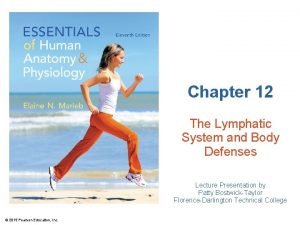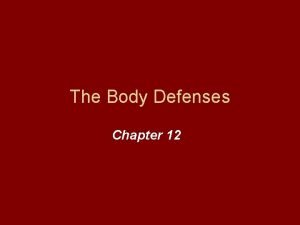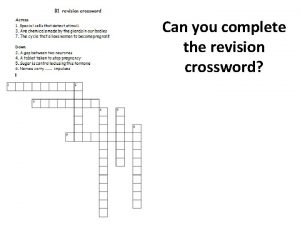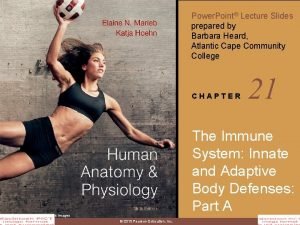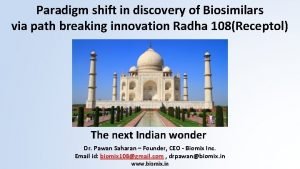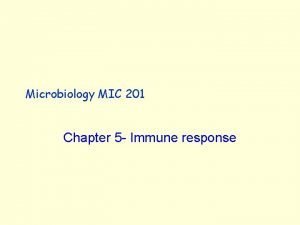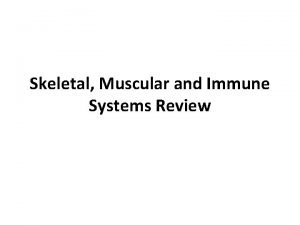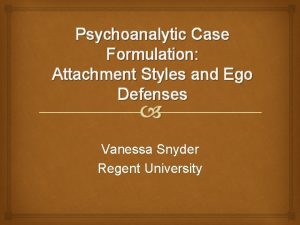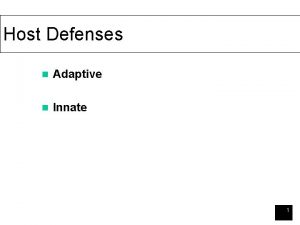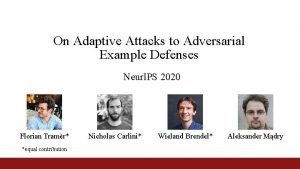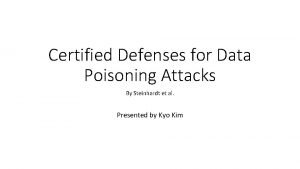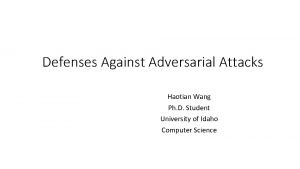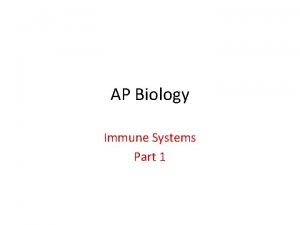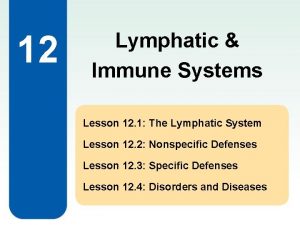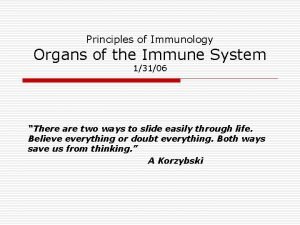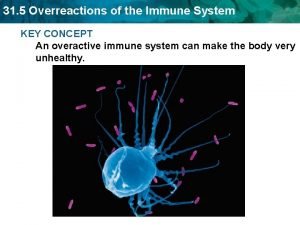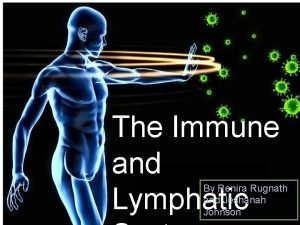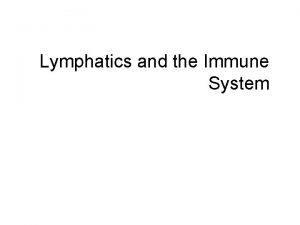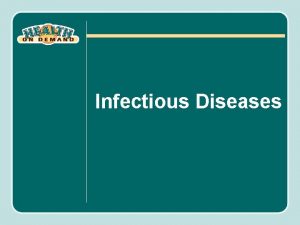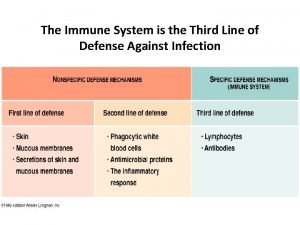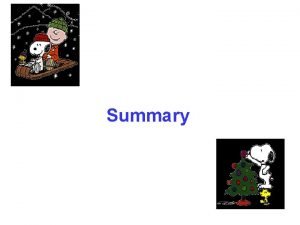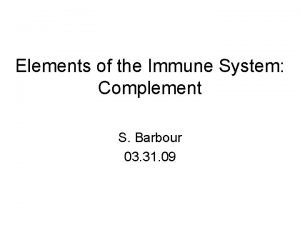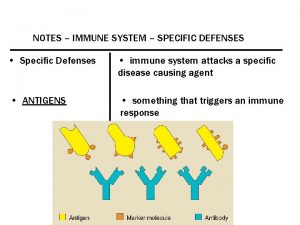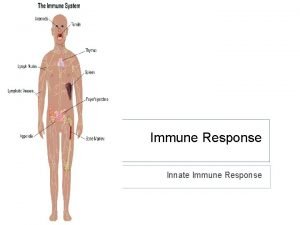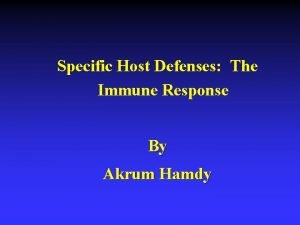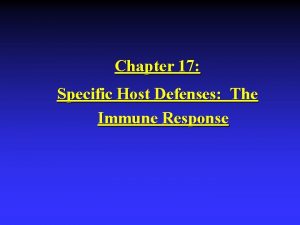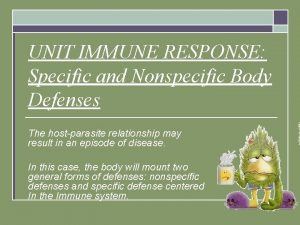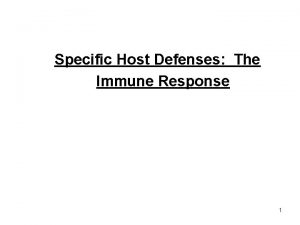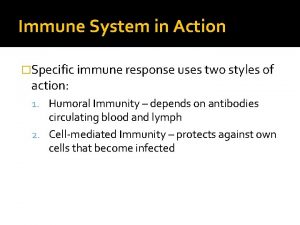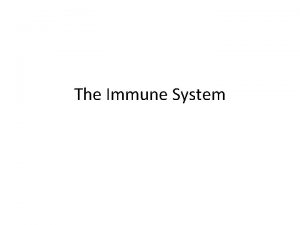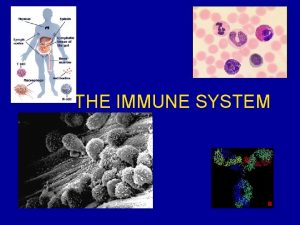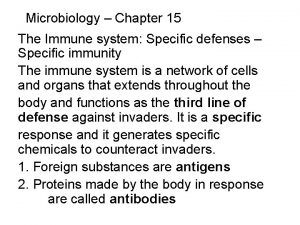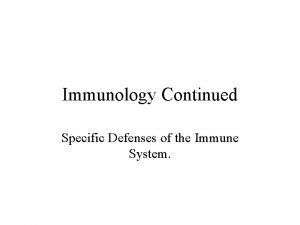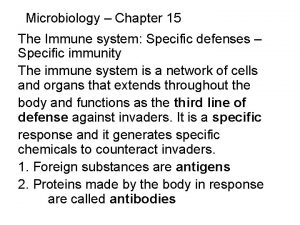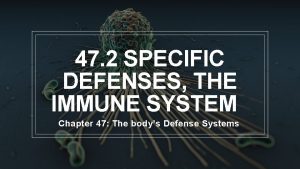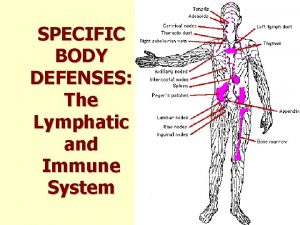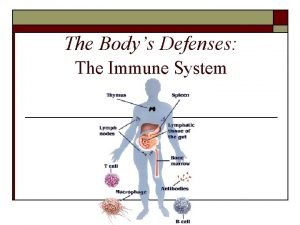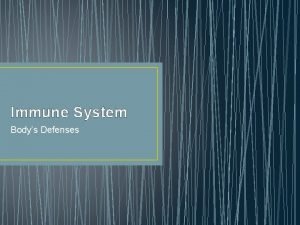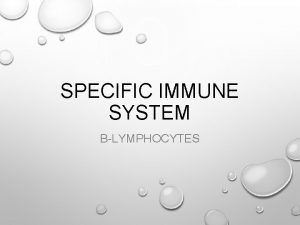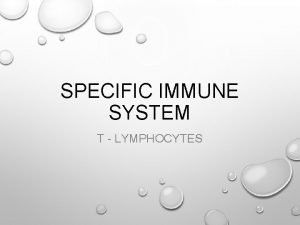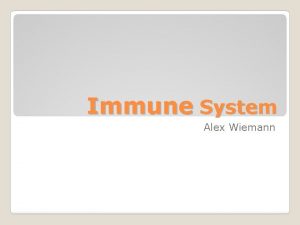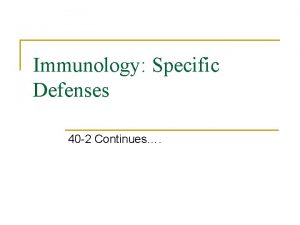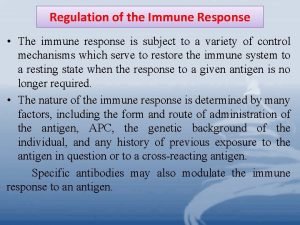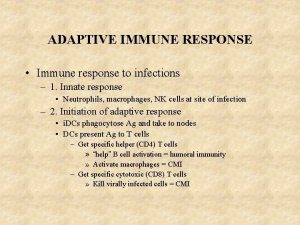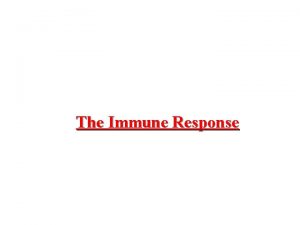3 Immune Response specific defenses Immune system consists



































- Slides: 35

3. Immune Response (specific defenses) – • Immune system consists of about (special type of white blood cell) distributed throughout the body but clustered in • Immune response results from interactions among the various types of lymphocytes and the molecules that they produce


• A successful immune response involves: 1. Recognizing an invader, 2. Launching a successful attack to overcome the invader, and 3. Retaining a memory of the invader to ward off future attacks

• Two key lymphocyte cells are involved in the immune response: • Arise from • Some of these cells are released into bloodstream and • http: //www. myasthenia. org. au/html/treatments. htm

6. 3. 5 Distinguish between antigens and antibodies. • Details of the Immune Response: • Step 1: • Antigens – Antigen (bacteria) • Can be Macrophage (usually large proteins, polysaccharides, and glycoproteins) • Antigens on our own cells B cell are recognized as “ ” (lymphocyte) releasing and do not stimulate an antibodies that immune response attack antigens http: //kids. britannica. com/elementary/art-89116/Special-cells-that-eat-antigens-are-a-part-of-natural

6. 3. 5 Distinguish between antigens and antibodies. • The surfaces of the body’s own cells bear large proteins and polysaccharides just like microbes do • These proteins are collectively called the • MCHs are one person’s MHCs would be recognized as foreign antigens in another person’s body Ø Which is why –

6. 3. 5 Distinguish between antigens and antibodies. • Any foreign material entering the body can act as an antigen and stimulate an immune response • “Anti-” means & “-gen” means , so antigen is an

6. 3. 5 Distinguish between antigens and antibodies. • Antibodies • • Y-shaped molecules made of 4 polypeptides ( ) • Antibodies have two sites that stick out and constantly look for antigens (and attach to antigens) and one site that sticks to the surface of its lymphocyte

6. 3. 5 Distinguish between antigens and antibodies. • Antibodies act in two ways: 1. Act as 2. Act as effectors and circulate in bloodstream • Tips of antibodies form for antigens – each site has a specific shape and binds only to a specific type of antigen



• – T-cells also have receptors on their surfaces • These are • Act (as compared to antibodies that act as receptors to trigger a response AND function in destroying foreign antigens)

• Details of the Immune Response: • Step 2: – the immune system mounts two types of attacks: 1. Humoral Immunity is provided by 2. Cell-mediated Immunity is produced by

6. 3. 6 Explain antibody production. Humoral Immunity • Produced by – because antibodies circulate in the bloodstream, humoral immunity can only defend against invaders in blood and extracellular fluid • B cells with specific antibodies on their surfaces bind to • Binding causes B cells to divide rapidly resulting population of cells are –

6. 3. 6 Explain antibody production. • Daughter cells differentiate into two cell types: 1. : do not release antibodies but play an important role in future immunity 2. : become enlarged and make huge quantities of their own specific antibodies that are released into bloodstream


• Antibodies destroy microbes in four ways: 1. Neutralization – antibody may 2. Promotion of phagocytosis – antibody may

3. Agglutination – antibodies have multiple binding sites and may bind to antigens on two different microbes, holding them together • • This 4. Complement reactions – the antibody-antigen complex on the surface of an invading cell may trigger a series of reactions with blood proteins called the • These complement proteins bind to antibodies and attract phagocytic cells or may directly destroy invaders by creating holes in their plasma membrane (similar to natural killer cells)


Cell-mediated Immunity • Produced by against , primary defense • Also important in overcoming infection by fungi or protists • Three types of cells contribute to cell-mediated immunity: 1. Cytotoxic T-cells 2. Helper T-cells 3. Suppressor T-cells

Cytototoxic T-cells • Release • This attack is activated when receptors on the cytotoxic Tcell’s membrane bind to antigens on surface of infected cell – create giant holes in target cell’s membrane Animation: http: //highered. mcgrawhill. com/sites/0072507470/student_view 0/chapter 22/animation__cytotoxic_tcell_activity_against_target_cells__quiz_1_. html

Helper T-cells • When receptors of these cells bind to an antigen, the cells (hormone-like) that assist other immune cells in their defense of the body • The chemicals released by Helper T-cells • Very little immune response (cell-mediated or humoral) can occur without the boost provided by helper T-cells (reason why AIDS is so deadly)

Suppressor T-cells • Act after an infection has been conquered – help to • After infection is over, some suppressor T cells and helper T cells remain and function as memory T cells to help protect the body against future exposure to the same antigen

• Details of the Immune Response: • Step 3: : • Memory cells allow us to retain immunity to antigens • B and T memory cells survive for many years

• If the body is exposed to antigens the immune system has previously encountered: Ø The appropriate • Second immune response is – invasion is overcome so fast, there

SECONDARY IMMUNE RESPONSE

Summary:

Summary:

6. 3. 8 Discuss the cause, transmission and social implications of AIDS. • AIDS – Acquired Immune Deficiency Syndrome • Cause: • Caused by two viruses – • HIV is a genetic material • AIDS describes the – contains RNA as its

6. 3. 7 Outline the effects of HIV on the immune system. • Effect: • HIV viruses • HIV reproduces by • Eventually the infected cell begins • Proliferating viruses eventually

6. 3. 7 Outline the effects of HIV on the immune system. • As the number of helper T-cells decline, the lymphocytes are • AIDS does not directly kill its victims, As the helper T-cell population declines they become more susceptible to opportunistic diseases


6. 3. 8 Discuss the cause, transmission and social implications of AIDS. • Transmission: 1. Sexual intercourse – virus is present in semen and vaginal secretions 2. In traces of blood on a hypodermic needle that is shared by IV drug abusers 3. Across the placenta from a mother to a baby, or through cuts during childbirth or in milk during breast-feeding

6. 3. 8 Discuss the cause, transmission and social implications of AIDS. 4. In transfused blood or with blood products such as Factor VIII used to treat hemophiliacs 5. Accidents causing blood contamination – the disease can be transmitted between a patient and a surgeon during operations, and between a patient and a dentist through cuts in open skin 6. Tattoos and ear piercing with infected needles

6. 3. 8 Discuss the cause, transmission and social implications of AIDS. • Social Implication of AIDS: • Due to ignorance about the methods of transmission, • HIV positive people may have difficulty • Sexual life styles have changed due to the awareness of and education about AIDS – • Children may become • May
 Primary immune response and secondary immune response
Primary immune response and secondary immune response Chapter 12 the lymphatic system and body defenses
Chapter 12 the lymphatic system and body defenses Chapter 12 the lymphatic system and body defenses
Chapter 12 the lymphatic system and body defenses Chapter 12 the lymphatic system and body defenses
Chapter 12 the lymphatic system and body defenses Active artificial immunity
Active artificial immunity 1st 2nd and 3rd line of defense immune system
1st 2nd and 3rd line of defense immune system Any substance capable of provoking an immune response
Any substance capable of provoking an immune response Primary immune response
Primary immune response Immune response controller crossword
Immune response controller crossword Primary and secondary immune response
Primary and secondary immune response Biosimilar study
Biosimilar study Cellular immune response
Cellular immune response Muscle type
Muscle type Splitting defense mechanism example
Splitting defense mechanism example Host defenses
Host defenses On adaptive attacks to adversarial example defenses
On adaptive attacks to adversarial example defenses Certified defenses for data poisoning attacks
Certified defenses for data poisoning attacks Certified defenses against adversarial examples
Certified defenses against adversarial examples What is the third line of defense in the immune system
What is the third line of defense in the immune system Hangman flowchart
Hangman flowchart 1st line of defense immune system
1st line of defense immune system Chapter 35 immune system and disease
Chapter 35 immune system and disease Ap bio immune system
Ap bio immune system Lesson 12 blood and immune system
Lesson 12 blood and immune system Lesson 12 blood and immune system
Lesson 12 blood and immune system Oobean
Oobean Immune system definition
Immune system definition Overreactions of the immune system
Overreactions of the immune system Lymphatic vs immune system
Lymphatic vs immune system Phagocitize
Phagocitize Defination of immune system
Defination of immune system What are the first line of defense
What are the first line of defense What is the main function of the immune system
What is the main function of the immune system Malt anatomy
Malt anatomy Thymus immune system
Thymus immune system Mac immune system
Mac immune system


